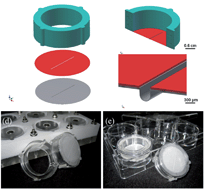Novel three-dimensional Boyden chamber system for studying transendothelial transport
Abstract
The rapid development in combinatorial chemistry of millions of novel potential

* Corresponding authors
a
Institute of Toxicology and Genetics, Karlsruhe Institute of Technology, Karlsruhe, Germany
E-mail:
ute.schepers@kit.edu
Fax: +0721 608 2 3354
Tel: +0721 608 2 3444
b Department of Tissue Regeneration, MIRA Institute for Biomedical Technology and Technical Medicine, University of Twente, Drienerlolaan 5, Enschede, NB, The Netherlands
c
Institute for Biological Interfaces, Karlsruhe Institute of Technology, Karlsruhe, Germany
E-mail:
stefan.giselbrecht@kit.edu
Fax: +0721 608 2 5546
Tel: +0721 608 2 4496
d Institute of Applied Life Sciences, Karlsruhe Institute of Technology, Karlsruhe, Germany
The rapid development in combinatorial chemistry of millions of novel potential

 Please wait while we load your content...
Something went wrong. Try again?
Please wait while we load your content...
Something went wrong. Try again?
I. Hebeiss, R. Truckenmüller, S. Giselbrecht and U. Schepers, Lab Chip, 2012, 12, 829 DOI: 10.1039/C2LC20733H
To request permission to reproduce material from this article, please go to the Copyright Clearance Center request page.
If you are an author contributing to an RSC publication, you do not need to request permission provided correct acknowledgement is given.
If you are the author of this article, you do not need to request permission to reproduce figures and diagrams provided correct acknowledgement is given. If you want to reproduce the whole article in a third-party publication (excluding your thesis/dissertation for which permission is not required) please go to the Copyright Clearance Center request page.
Read more about how to correctly acknowledge RSC content.
 Fetching data from CrossRef.
Fetching data from CrossRef.
This may take some time to load.
Loading related content
